
When Digimon Story: Time Stranger was first announced in February, I wasn’t quite sure what to make of it. I hadn’t been completely satisfied with the last few Digimon games I’d tried. Digimon Story: Cyber Sleuth and Hacker’s Memory were originally designed for the PS Vita, so some of their shortcomings could be excused, as they were built for less powerful hardware. However, Digimon Survive, the adventure game from 2022 that featured strategic RPG battles, didn’t appeal to me because I felt it didn’t deliver on a promising idea.
I usually try to go into new games without letting my past experiences with the series color my judgment, but honestly, I was pretty indifferent to Digimon Time Stranger at first. Previous Digimon games had disappointed me so much that I just didn’t have high hopes. But then I actually got to play it at Summer Game Fest and PAX West, and that totally changed things! It started to feel really special – there was a certain charm to it that reminded me of classic Japanese RPGs from the PS2 days. I started to get really excited about it.
Recently, the video game industry has seen a strong desire to bring back the feeling of playing games from our childhoods. This trend appears as remasters, remakes, and completely new games that are inspired by classic titles. These older games were able to capture the imagination of players, even with some aspects that might seem a little rough or clunky by today’s standards.
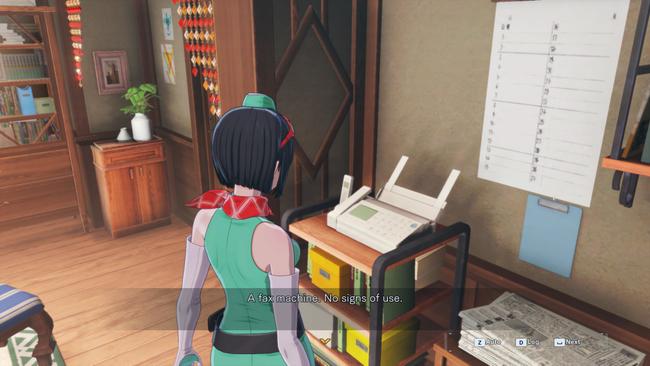
I’m bringing all this up because I genuinely believe Time Stranger is a fantastic game. It really captures the feeling of classic JRPGs from the PlayStation 2 era – the good *and* the bad. It has a well-written story, characters you’ll enjoy spending time with, and a satisfying way to improve your team. However, it also has some frustrating parts, like having to navigate too many menus when training your Digimon, a clunky fast travel system, and some inconsistencies in how the story is told.
Even if you don’t know anything about Digimon, I believe Time Stranger is a fantastic RPG on its own. If you’re even a little curious about the unique designs of the digital monsters you can play as in this game, you might find yourself really hooked. It’s that engaging!
In Time Stranger, you play as a secret agent working for the mysterious ADAMAS organization, which investigates strange occurrences globally. Players can select either Dan or Kanan as their character-Dan is the male protagonist, and Kanan is the female one. A unique feature is the ability to switch between characters at any time, and even change their name through the options menu after starting the game. For the purpose of this review, I’ll be referring to my character as Kanan, as that’s who I chose and kept her original name.
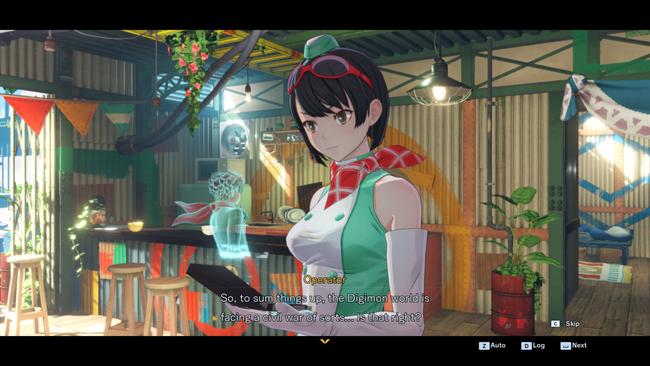
The beginning of Time Stranger is intentionally strange and dreamlike. Following a chain of bad luck that leads to the devastating Shinjuku Inferno, players are unexpectedly transported eight years into the past. Initially, the main objective is straightforward – figure out how to return to the present day, and while doing so, gather information that might help prevent the Shinjuku Inferno from ever happening.
The beginning of this game progresses at a deliberate pace. Time Stranger carefully introduces Inori Misono, a key character, and the other important figures connected to the Human World storyline. To be honest, I found it a little sluggish because the gameplay mostly involved repeatedly playing through the same sewer level for several hours. While I understand and respect the choice to focus on story development early on, I believe this section would have benefited greatly from having another area to explore, to make things more engaging.
Eventually, Inori encounters Aegiomon, another key character in Time Stranger. For a good portion of the game, Inori and Aegiomon feel like the true protagonists, largely because the player character remains silent for much of the experience.
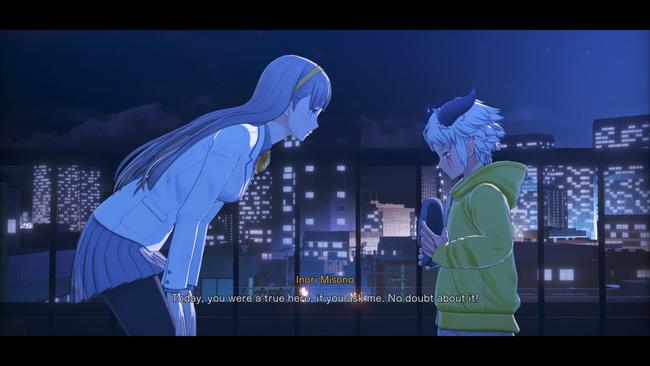
The second protagonist, Dan in my playthrough, acts as the person communicating with your chosen character, and their conversations are largely spoken. However, Kanan didn’t have any voice acting for the choices you make or during story scenes, which made her feel distant from the story because most other characters *did* have voiced lines. Most of Kanan’s spoken lines were limited to just a few lines during combat. This feeling of separation is made even worse because Kanan sometimes moves her mouth as if she’s speaking during dialogue, but there’s no sound at all.
It took about four or five hours for me to really get into Time Stranger, which is when Kanan, Inori, and Aegiomon first journey to the Digital World: Iliad. Just so you know, Iliad is a completely separate Digital World from the one shown in the original Digimon anime seasons. I really enjoyed those first three seasons, so it took me a while to realize that the Iliad in Time Stranger is a Digital World running on a different system.
I first began to really enjoy this game when I explored Central Town. The level of detail that brings the Digital World to life in Time Stranger is truly amazing. Everywhere you look in this area, you’ll find tons of Digimon, even a bar completely packed with Digimon just relaxing and hanging out. It’s a fantastic touch.

The same holds true for all the different locations players will explore in Iliad. Each area is filled with Digimon that fit the environment, coming in various forms and often interacting playfully. For example, the Gear Forest is home to many insect Digimon, such as FunBeemon, Kabuterimon, and Kuwagamon. In contrast, the Abyss Area features a lot of water and beach-themed Digimon, including Seadramon, ShellNumemon, and even a MarineAngemon putting on a show for a small audience.
Perhaps the biggest success of Time Stranger is that it’s the first Digimon game to truly demonstrate it was given the necessary time, attention, funding, and effort to vividly bring the Digital World to life. While Cyber Sleuth and Hacker’s Memory still felt limited by their origins on the PS Vita, even in their Complete Edition releases, Time Stranger clearly benefits from being built and designed specifically for modern gaming hardware.
Leading up to the release of Time Stranger, the developers repeatedly highlighted that this Digimon Story game would feature the biggest collection of Digimon ever – boasting over 450 creatures. This large number initially made me think they would be reusing and updating models from earlier Digimon Story titles. However, a development video revealed that every single Digimon model was built from scratch. They even showed direct comparisons between models in Cyber Sleuth and Time Stranger, making it obvious that the Time Stranger models were entirely new and significantly more detailed.
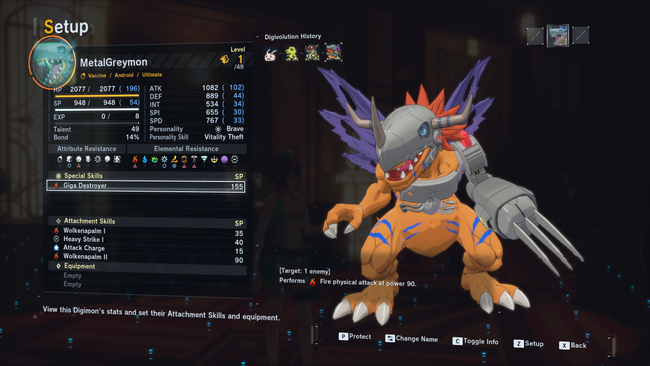
I really made an effort to complete the entire Field Guide in Time Stranger – it’s like the Pokedex – just to see all of the Digimon. They are incredibly well-designed, and it’s a remarkable feat to create and animate so many Digimon, especially while giving each one a unique personality. It’s truly impressive.
Before we go any further, let me quickly explain how Digimon evolve. As Digimon grow stronger, they go through several stages: In-Training, In-Training II, Rookie, Champion, Ultimate, and finally Mega. Digimon don’t follow a single path; they have a branching evolution tree, meaning there are often multiple Digimon they can become – these are called Digivolutions. They can also De-Digivolve, which means reverting to an earlier stage. For example, a Champion could De-Digivolve back into a different Rookie form it previously evolved from, and that Rookie could then take a completely different path of Digivolutions. It’s a flexible system, allowing for diverse possibilities.
Okay, so one of the biggest changes from past Digimon Story games is how Digivolution works now. Instead of having to go to a separate DigiLab, I can just access Digivolutions right from the menu – super convenient! And the Digimon storage, which used to be called the DigiBank, is always with me now. It can hold up to 999 Digimon, and the cool thing is, all my stored Digimon actually gain experience points from battles! These little tweaks and improvements make Time Stranger a much smoother experience overall, honestly.
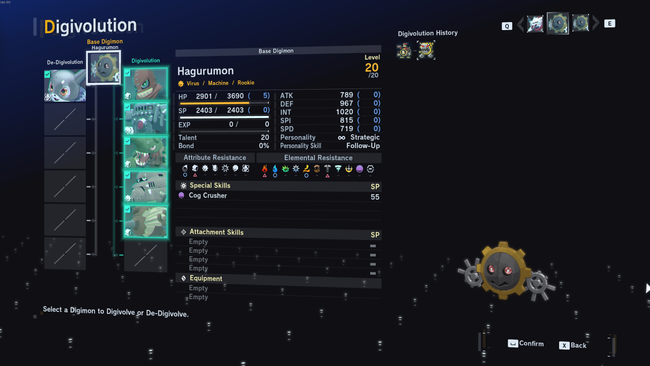
In this game, Digimon Digivolve when they meet specific stat requirements. You can see these requirements clearly by hovering over each possible Digivolution. Time Stranger also adds a new Agent Rank system, which helps control how quickly players become powerful. Previous Digimon Story games had ways to reach higher evolution stages very quickly, often by exploiting loopholes. Time Stranger aims to prevent this by tying Agent Rank to Anomaly Points. You earn these points by completing the main story and side quests. These Anomaly Points are then used on Kanan’s gun to unlock new X-Art abilities, boost Digimon stats based on their personality, and lower the requirements for Digivolving, among other things.
I really liked this system because it made getting stronger feel natural as the story went on. It was super satisfying when I finally hit the Agent Ranks needed to unlock Champion, Ultimate, and Mega forms – seriously, almost every Digimon I had was suddenly ready to Digivolve! Time Stranger does a good job of spreading out those big milestones, and it gave me a really good reason to do all the side quests so I could level up my Agent Rank faster.
The side quests are generally quite simple, but many of them connect to form a continuing story that builds on what happened earlier in the game. Digimon Story games often include strange and occasionally questionable quests, as Digimon frequently find themselves in situations caused by humans. This usually creates funny moments, and Time Stranger keeps that going. I feel like some of these quests, and a few parts of the main story, require a lot of going back and forth, which feels a bit old-fashioned since most newer games have moved past that-though PS2-era JRPGs definitely had their share of backtracking.
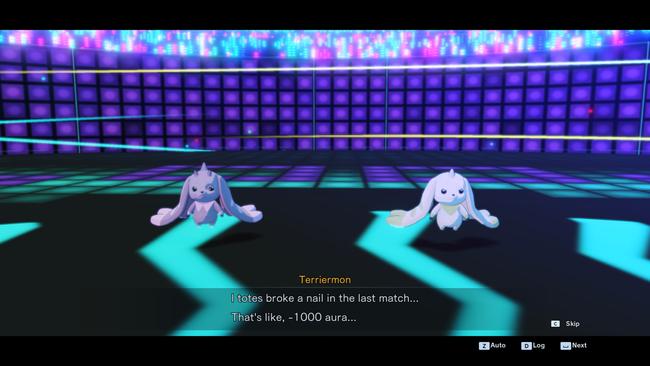
I was surprised by how often side quests appeared in Time Stranger. The game carefully introduces a small number of them over most of Kanan’s adventure, ensuring they don’t distract too much from the main story. However, following a common pattern in this type of game, a large number of side quests became available just before the end of the main story.
Just so you know, a lot of the costume DLCs in the Deluxe and Ultimate Editions actually come with their own little side quests. They’re super quick and easy – usually you just need to talk to an NPC or find a reason to wear the costume, maybe have a quick battle, and you’re done. Don’t expect to get any Anomaly Points from them though; these DLC packs won’t help you level up faster. They’re more about the costume itself than actually progressing in the game.
When it comes to battles, Time Stranger’s system is somewhat uneven. While the core mechanics are good, it truly excels during boss fights. It’s a simple turn-based system that uses a timeline to determine the order of actions. Players can have up to six Digimon in their primary party, but only three can participate in a battle at once. There are also three extra slots for guest characters; Aegiomon is a guest you can directly control, with his own HP and SP. Other guest Digimon will act independently and are invincible, allowing them to occasionally absorb damage.

Switching an active party member with a reserve doesn’t take a turn, and you can do it as many times as needed as long as the reserve member hasn’t started an action. Using a consumable item also doesn’t cost a turn, but you can only use one item each turn. These rules are important in the design of the Time Stranger’s boss fights, as the boss frequently attacks multiple party members with things like stat reductions, status effects, and constant stat boosts.
The core of combat in Time Stranger lies in learning how to exploit a Digimon’s weaknesses to significantly increase its damage output. Most Digimon fall into one of three categories – Vaccine, Data, or Virus – which interact with each other in a traditional rock, paper, scissors fashion. Beyond these types, many Digimon also have specific elemental strengths and weaknesses, and possess unique Traits. The damage system carefully balances these three factors: type, element, and traits, to ensure fair fights.
For instance, a Gotsumon is a Data-type Digimon, meaning it’s strong against Vaccine Digimon and weak against Virus Digimon. It’s vulnerable to Grass and Wind attacks, but resistant to Water and unaffected by Earth. Its defining characteristics are Medium and Mineral. If I attacked it with a standard attack from a Virus-type Digimon, the damage would be doubled (x2 multiplier). I could increase this damage further if that Virus-type Digimon used a wind spell; if the Virus-type Digimon also had a special wind attack that deals extra damage to Digimon with the Mineral trait, the damage multiplier could reach up to 450%. Conversely, using a water ability with a Vaccine-type Digimon would only do minimal damage.
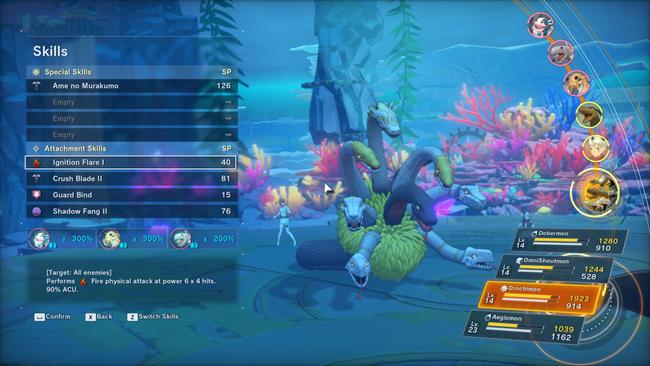
The battle interface clearly shows how much extra damage you’ll do when you move the cursor over abilities. Successfully hitting an enemy’s weaknesses slowly fills up Kanan’s X-Arts (pronounced Cross Arts) meter. What happens when you use an X-Art is up to you – they can buff your team, damage enemies, or heal your allies when they’re low on health. This system works both ways, though, so you might see a Digimon’s health bar drop quickly if its weaknesses are being targeted. It’s important to be aware of this!
Boss battles are frequently interesting because they introduce unique gameplay elements. For instance, one early boss fight features a Digimon controlling a machine with many arms-each arm is a different type, meaning they each have different weaknesses to various Digimon. The boss unleashes a devastating attack after a certain number of turns, utilizing all of its arms, but this attack can be reduced in power and ultimately stopped completely as more and more arms are destroyed.
I don’t want to spoil some of the more inventive boss designs, but I especially liked the boss battles in Time Stranger. They frequently surprised me, though occasionally beating them involved a lot of trial and error, especially when my party’s types or elemental weaknesses were heavily exploited by the boss. The game also differentiates between physical and magical attacks, which matters because shields can temporarily block one type of damage completely.
During a fight, bosses often enter a “charge up” phase, indicated by a new bar appearing. While this bar fills, preparing a powerful attack, a different part of the boss becomes vulnerable to attacks. Hitting this vulnerable spot lowers the charge-up bar. If you deplete the bar in time, the boss will be briefly stunned. However, if you fail… that’s where the guard command comes in handy.
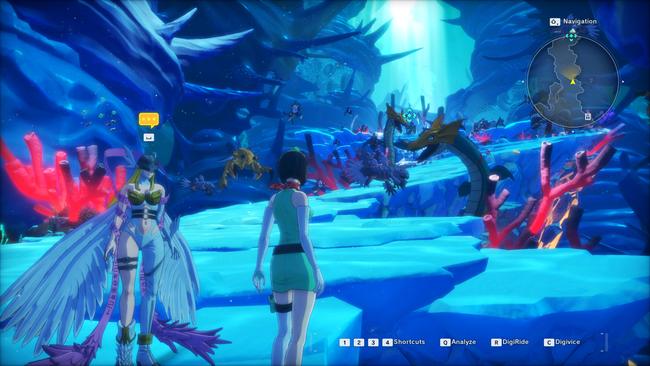
However, most of the smaller, non-boss battles aren’t very interesting. If my team wasn’t clearly weaker, I could almost always win by using the auto-battle function. I often found myself using the x5 battle speed in Time Stranger and just letting fights play out on their own, even on Hard mode. The Mega and Mega+ difficulties, which become available after completing the game, are much more challenging; enemy stats are significantly higher from the start, even for fully-equipped teams. So, players who want a real challenge in every fight will need to unlock those first.
I don’t really enjoy how straightforward regular battles can be, but I see why they’re useful. When you defeat a Digimon, its convert meter goes up. If you fill that meter to 100%, you can get that Digimon right away. However, if you wait and increase it up to 200%, the Digimon will join with a higher level cap and better stats. One confusing part of the game is that you have to stand still for a few seconds to completely restore the party’s HP and SP. I would have preferred if they just healed fully after each battle, instead of this extra step. Overall, I think Time Stranger’s battle system works well when players really try to understand it and use it effectively. It encourages thorough engagement with the mechanics.
Every Digimon boasts at least one unique attack that only it can use, and more powerful forms like Ultimate or Mega Digimon typically have two or three. Each of these signature attacks features a special animation, and the Digimon verbally announces the attack’s name as it’s used. Because Time Stranger includes an English dub – something previous Digimon Story games lacked – there’s a wide variety of English voice acting just for these attacks, and you’ll also hear the lines during the victory animations. As I noted before, this level of detail in Time Stranger really shows a lot of care and passion, bringing to mind classic RPGs.

Digimon are also able to learn up to four attachment skills. These skills are gained as Digimon gain experience and level up, and can also be purchased from shops. Attachment skills include abilities based on elemental strengths that increase either physical or magical damage, skills that restore health, and buffs or debuffs to stats. Because they are fully interchangeable, when a Digimon learns a new attachment skill at a certain level, you can remove it and assign it to a different Digimon.
Many of the Digimon in Time Stranger can be ridden. Surprisingly, not all of them offer a speed boost over running; the way you mount each Digimon varies. Kanan can ride on a Digimon’s shoulder or back, but some, like Beelzemon and Witchmon, let her ride behind them on their motorcycle and flying broom, respectively. It’s a little disappointing that there are no sounds when riding a Digimon, but overall, it’s a fun addition to the game.
A particularly interesting addition to Time Stranger is the introduction of “temporary” DNA Digivolution attacks. In the world of Digimon, certain Digimon can fuse together to create a completely new form; a classic example is the combination of ExVeedramon and Stingmon to create Paildramon. Usually, DNA Digivolution results in a permanent combination, unless the Digimon reverts to a previous form. However, in Time Stranger, DNA Digivolutions can now be utilized as single, one-time attacks.
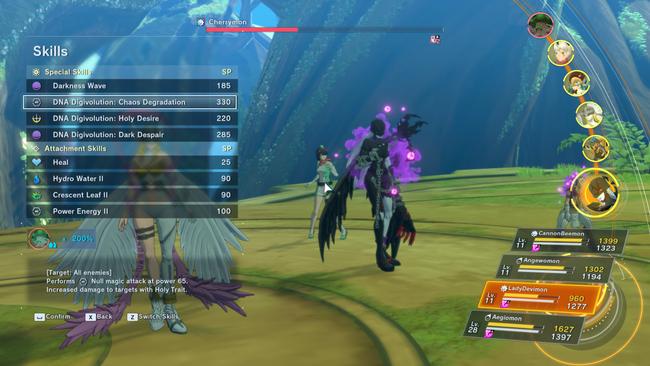
If both ExVeemon and Stingmon are on the field, they gain access to new attack options featuring “DNA Digivolution.” Selecting these attacks causes the two Digimon to temporarily combine into Paildramon to perform the attack, then split back apart. Using this ability will use up both Digimon’s turns, as well as the SP required for the attack.
The DigiFarm in Time Stranger lets you improve your Digimon’s stats automatically, even while they’re not actively battling. Digimon placed in the DigiFarm continue to gain experience points just as if they were stored in your Digimon inventory box. What makes the DigiFarm special is that the training items you use to boost stats can be used again and again.
For example, I’m trying to increase Leomon’s Attack stat to 2200, which is the requirement for it to Digivolve into IceLeomon. I have five training programs that give a moderate boost to Attack, so I assign one to Leomon, and it takes one hour of real-time to complete. After it’s finished, the training program is returned to me and can be used again. If an hour seems like a long wait, players can use in-game currency to finish the training instantly.
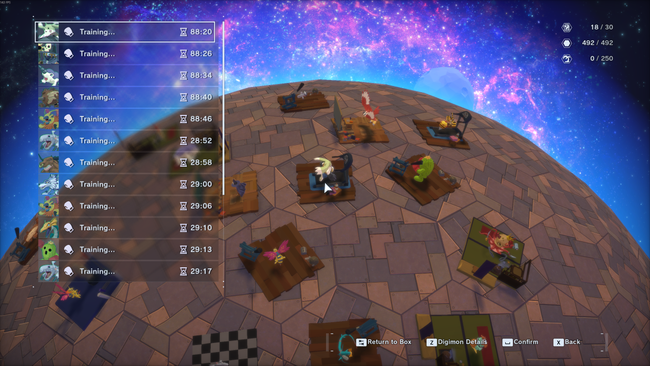
I began playing Time Stranger with a notepad because of the DigiFarm. Before I even put any Digimon in it, I carefully planned which Digimon would go with each of my Training Sets to maximize their stats and get them to Digivolve. You can create new training sets at the Zudomon blacksmith; I eventually started saving most of my in-game currency to quickly finish sets that took 90 minutes, because it cost the same as speeding up shorter, 30-minute sets. I found this was a more efficient way to progress.
It became frustrating switching between the DigiFarm and Digivolution menus while completing my Field Guide. I really wish there was a way to open a Digimon’s Digivolution menu directly from within the DigiFarm interface itself.
The Time Stranger’s Outer Dungeons offer a fun and visually interesting break from the main game. Don’t think of these sections as just extra content for leveling up, earning money, or gathering items. Instead, they’re hidden red rifts that take you to a minigame. Successfully completing the minigame will reward you with a stronger Digimon.
Several minigames are available, such as racing a Digimon while steering clear of obstacles, and trying to survive waves of Digimon appearing in a confined arena for ninety seconds. Time Stranger also features a straightforward collectible card game – each Digimon has a corresponding card, offering another quick and enjoyable diversion. These were brief, but pleasant, activities.

Finally, I thought the fast travel system in this game felt a bit outdated – reminiscent of games from the PS2 era. Unlike many newer RPGs, there isn’t an instant fast travel option accessed through a menu. Instead, after completing an area, a Birdramon NPC will offer players a choice of key locations to travel to instantly, but this only works within that particular zone.
Imagine I want to travel from Gear Forest Village to the Warrior’s Watering Hole bar in Central Town. First, I need to find Birdramon in Gear Forest Village and tell them I want to take the Locomon train to Gear Forest. Then, I have to speak with Locomon and select Central Town on the map. Once I arrive in Central Town, I need to find Birdramon again and finally choose the Warrior’s Watering Hole destination. This process gets even more complicated when the story adds more details. It’s a rather awkward system, reminiscent of older RPGs and how they used to handle travel.
It took me about 60 hours to finish Time Stranger the first time, but around 20 of those hours were dedicated to completely filling out the in-game Field Guide. I’d estimate a typical playthrough will likely be around 40-45 hours long, especially if you don’t focus on completing every single Digimon’s Digivolution tree. It’s a pretty long game, but it manages to stay engaging throughout.
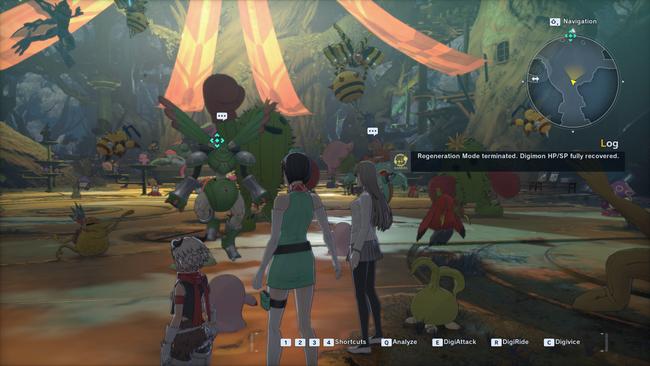
Digimon Story: Time Stranger is a fantastic game that truly captures the feel of classic PlayStation 2-era JRPGs. The developers clearly put a lot of love and effort into creating the Digital World: Iliad and all the Digimon who live there. The story has its moments, with both highs and lows, but it takes some surprising turns and ends on a very high note – Digimon fans are going to love the finale! While there are a few rough edges, like the fast travel system and the fact that the main character doesn’t have a voice, it’s undeniable that this is not only one of the best Digimon games ever made, but also a genuinely great game in its own right.
8
We tested the PC version of the game. Digimon Story: Time Stranger is also playable on PlayStation 5 and Xbox Series X|S.
Read More
- Where Winds Meet: March of the Dead Walkthrough
- Mark Wahlberg Battles a ‘Game of Thrones’ Star in Apple’s Explosive New Action Sequel
- Physical: Asia fans clap back at “rigging” accusations with Team Mongolia reveal
- LTC PREDICTION. LTC cryptocurrency
- Invincible Season 4 Confirmed to Include 3 Characters Stronger Than Mark Grayson
- EUR AUD PREDICTION
- Dragon Ball Meets Persona in New RPG You Can Try for Free
- Marvel Cosmic Invasion Release Date Trailer Shows Iron Man & Phoenix
- November 2025 Movie Releases: Predator, Wicked, & More
- Top Disney Brass Told Bob Iger Not to Handle Jimmy Kimmel Live This Way. What Else Is Reportedly Going On Behind The Scenes
2025-10-01 17:06